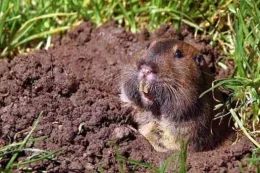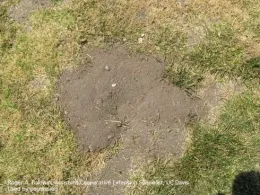It's Groundhog Day!

In California, we can't rely on Phil. Instead, we have gophers which are active all year. This makes them an unreliable source of information about the start of spring, since they are constantly popping up out of their burrows. Incidentally, spring officially starts on March 20 this year.
For gardeners, the presence of gophers can be frustrating. Most can tolerate a few insects on plants, or a small patch of a disease that can be cut off. However, just one gopher can consume an entire vegetable garden or dig multiple holes in the lawn and landscape in a short amount of time.

What made the holes in my garden or landscape?
If you see a hole, it might be a gopher or a mole. Gophers digging in lawns and landscapes leave holes that look like the photo to the right. Typically, they are crescent or horseshoe in shape. As they dig tunnels, gophers move fresh soil to the surface. You can usually see a plugged hole next to the mound.
Moles are another burrowing animal that also create mounds. However, their mounds are more circular, as shown in the photo in this post.
To learn more about gophers and how to control them, visit the UC IPM Pest Notes: Pocket Gophers.
If you suspect the holes in your landscape or garden are made by another animal, read the UC IPM Pest Notes: Ground Squirrels.
